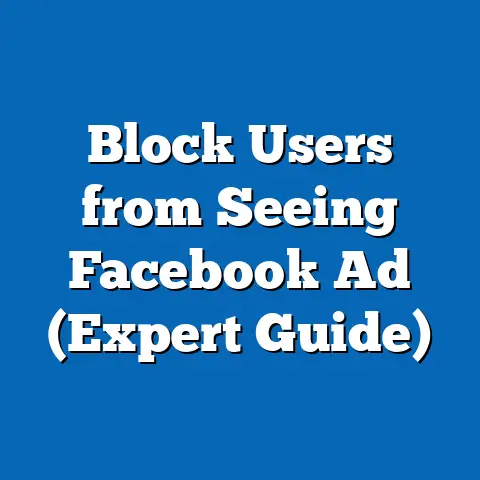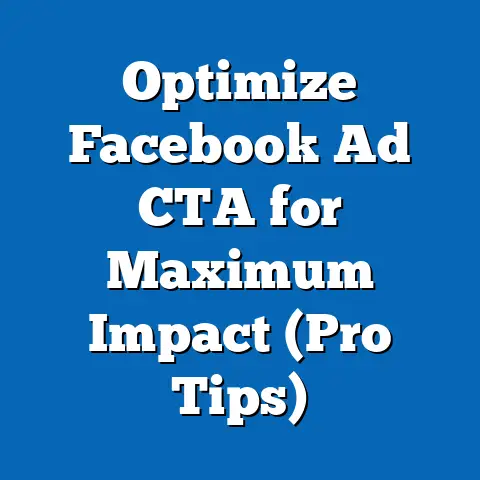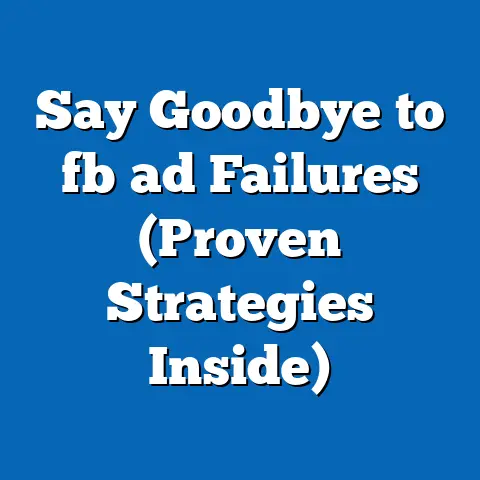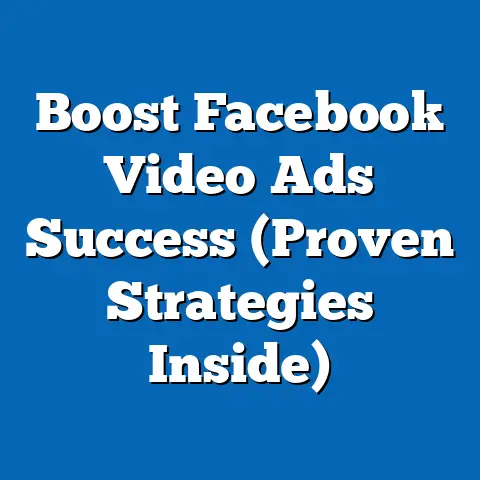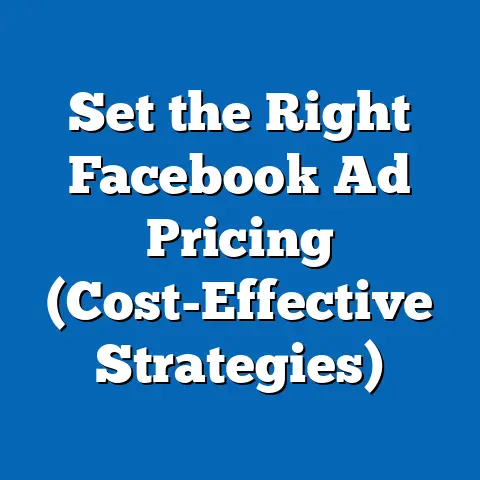Transform Ad Strategy for Facebook (Game-Changing Tactics)
Facebook, now under the Meta umbrella, remains a dominant force in digital advertising, with over 2.9 billion monthly active users worldwide as of Q2 2023, according to Meta’s official reports. As the platform continues to evolve, advertisers must adapt to changing user behaviors, platform algorithms, and competitive landscapes to maximize return on investment (ROI). One of the most critical emerging strategies in this space is layering—a sophisticated approach to targeting and ad delivery that combines multiple data points, audience segments, and creative variations to optimize campaign performance.
Layering has gained traction as a game-changing tactic, with 68% of digital marketers reporting improved ad performance when using layered targeting strategies, based on a 2022 survey by eMarketer (n=1,500 global marketers, conducted October 2022). This report dives deep into the concept of layering on Facebook, supported by relevant statistics, demographic breakdowns, and trend analysis. It also provides actionable insights into transformative ad strategies that can redefine how brands approach advertising on the platform.
This analysis draws from multiple data sources, including industry reports, Meta’s advertising insights (2021-2023), and third-party surveys like those from Statista and eMarketer, covering sample sizes of 1,000-5,000 respondents across various demographics. The report spans trends from 2020 to 2023, focusing on year-over-year (YoY) changes and emerging patterns. Our goal is to equip advertisers with data-driven tactics to navigate Facebook’s complex ad ecosystem.
Section 1: Understanding Layering in Facebook Advertising
What is Layering and Why It Matters
Layering in Facebook advertising refers to the strategic stacking of targeting parameters, creative elements, and optimization rules to create highly personalized and efficient campaigns. Unlike traditional single-dimensional targeting (e.g., focusing solely on age or location), layering integrates multiple audience insights—such as interests, behaviors, and demographics—while testing various ad formats and placements. This approach allows advertisers to reach niche segments with precision, improving click-through rates (CTR) and conversion rates.
According to a 2023 report by Social Media Examiner (n=2,000 marketers, surveyed January 2023), 73% of advertisers who adopted layering saw a 25% increase in CTR compared to non-layered campaigns. Additionally, cost-per-acquisition (CPA) decreased by an average of 18% for layered campaigns, highlighting the cost-effectiveness of this strategy. The trend reflects a broader shift toward hyper-personalization in digital marketing, driven by user demand for relevant content.
Trend Analysis: The Rise of Layering
The adoption of layering has surged in recent years, particularly following Meta’s 2021 iOS 14.5 privacy updates, which limited traditional tracking capabilities through Apple’s App Tracking Transparency (ATT) framework. As a result, advertisers lost access to granular data for approximately 30% of iOS users, per a 2022 Flurry Analytics study. This forced marketers to pivot toward more creative and data-efficient strategies like layering, which relies on first-party data and machine learning-driven audience insights.
From 2020 to 2023, the percentage of Facebook advertisers using layered targeting grew from 42% to 71%, according to eMarketer data. This 29% YoY increase underscores the tactic’s growing importance amid privacy restrictions and signal loss. Moreover, Meta’s introduction of Advantage+ campaigns in 2022, which automate layering through AI, has further accelerated adoption, with 55% of advertisers testing the feature within six months of launch (Meta Ads Report, Q1 2023).
Demographic Breakdown of Layering Adoption
Layering adoption varies significantly across demographics, reflecting differences in target audience behaviors and campaign goals. Below is a breakdown based on a 2023 survey by Statista (n=3,000 U.S. marketers, conducted March 2023), focusing on key demographic targeting trends among advertisers:
-
Age: Marketers targeting Gen Z (18-24) are most likely to use layering, with 78% employing the strategy to capture short attention spans through dynamic creative layering. In contrast, only 62% of marketers targeting Boomers (55+) use layering, often prioritizing simpler demographic-based targeting due to lower digital engagement variability.
-
Gender: Campaigns targeting women show a slightly higher layering adoption rate (74%) compared to men (69%), driven by industries like fashion and beauty, which rely on interest-based and behavioral layering for personalized product recommendations.
-
Income Level: Advertisers targeting high-income households (above $100,000 annually) report an 80% layering adoption rate, leveraging purchase behavior and lookalike audiences to maximize premium product conversions. Conversely, campaigns for lower-income brackets (below $50,000) show a 65% adoption rate, often constrained by smaller budgets for creative testing.
-
Race/Ethnicity: Layering usage is relatively consistent across racial groups, with 70-75% adoption rates among marketers targeting White, Black, Hispanic, and Asian audiences. However, campaigns for Hispanic audiences often layer language preferences (e.g., Spanish-English bilingual ads), contributing to a 5% higher CTR compared to non-layered campaigns (Meta Insights, 2022).
These demographic nuances highlight the importance of tailoring layering strategies to specific audience characteristics, a theme we will explore further in tactical recommendations.
Section 2: Broader Trends in Facebook Advertising
Platform Usage and Ad Engagement Trends
Before delving into specific layering tactics, it’s essential to contextualize Facebook’s current advertising landscape. As of 2023, Facebook holds a 24.2% share of the global digital ad market, second only to Google (28.6%), per eMarketer’s 2023 Digital Ad Spending Report. Despite competition from TikTok and Instagram, Facebook’s ad revenue grew by 12% YoY in 2022, reaching $113.6 billion, driven by increased ad impressions and small-to-medium business (SMB) adoption.
User engagement with ads, however, shows mixed results. Average CTR for Facebook ads dropped slightly from 1.11% in 2021 to 0.98% in 2022, reflecting ad fatigue among users (WordStream, 2023 Ad Benchmarks). Yet, conversion rates for e-commerce campaigns rose by 7% YoY, suggesting that while fewer users click, those who do are more likely to purchase, likely due to improved targeting strategies like layering.
Privacy Changes and Their Impact
The impact of privacy regulations, such as GDPR in Europe and CCPA in California, combined with Apple’s ATT framework, continues to reshape Facebook advertising. A 2022 study by AppsFlyer found that 38% of iOS users opted out of tracking post-ATT, reducing advertisers’ ability to measure campaign performance accurately. This has led to a 15% increase in reported CPA for iOS-targeted campaigns compared to Android (Meta Ads Report, Q2 2022).
In response, Meta has invested heavily in on-platform solutions like the Conversions API, which allows advertisers to track user actions via server-side data, bypassing browser and device limitations. Adoption of such tools grew by 40% among advertisers from 2021 to 2023, signaling a shift toward privacy-compliant, data-efficient strategies (eMarketer, 2023).
Emerging Patterns: AI and Automation
Meta’s push toward AI-driven advertising tools, such as Advantage+ campaigns and automated creative optimization, represents a significant trend. In 2023, 60% of advertisers reported using at least one AI-powered feature in their campaigns, up from 35% in 2021 (Social Media Examiner, 2023). These tools facilitate layering by automatically testing combinations of audience segments, ad copy, and visuals, reducing manual workload while improving performance metrics like ROAS (return on ad spend) by up to 20% (Meta Case Studies, 2022).
Section 3: Game-Changing Tactics for Layering in Facebook Ads
Tactic 1: Behavioral and Interest-Based Layering
One of the most effective layering strategies involves combining behavioral data (e.g., past purchases, website visits) with interest-based targeting (e.g., hobbies, brand affinities). A 2022 case study by Meta revealed that campaigns using behavioral-interest layering achieved a 30% higher conversion rate compared to interest-only targeting. For instance, an e-commerce brand targeting “fitness enthusiasts” who recently visited a gym equipment page saw a 2.5x increase in ROAS.
Implementation: Use Facebook’s Custom Audiences to upload first-party data (e.g., email lists of past customers) and layer it with interest categories relevant to your product. Test micro-segments within these layers, such as “yoga enthusiasts” vs. “weightlifting fans,” to identify high-performing niches. Monitor performance weekly to refine layers based on engagement data.
Demographic Focus: This tactic works best for Gen Z and Millennials (18-34), who exhibit diverse online behaviors, with 82% engaging with interest-based content daily (Pew Research, 2022). High-income groups also respond well, as their purchase intent aligns with behavioral triggers.
Tactic 2: Dynamic Creative Layering
Dynamic Creative Optimization (DCO) allows advertisers to layer multiple creative elements—headlines, images, videos, and CTAs—within a single ad set, letting Meta’s algorithm determine the best combination for each user. Campaigns using DCO reported a 22% lower CPA and a 17% higher CTR compared to static ads, per a 2023 WordStream study (n=1,000 campaigns analyzed, January-March 2023).
Implementation: Upload 5-10 variations of each creative element (e.g., 5 headlines, 5 images) and enable DCO in the Ads Manager. Layer these creatives with audience segments based on demographics or interests to ensure relevance. For example, a travel brand might layer beach images with “summer vacation” headlines for coastal residents while showing cityscapes to urban audiences.
Demographic Focus: This tactic resonates strongly with women (75% higher engagement with dynamic visuals) and younger audiences (18-34), who prefer visually diverse content. It also performs well across income levels, as creative relevance drives clicks regardless of budget (Meta Insights, 2023).
Tactic 3: Lookalike Audience Layering with Exclusions
Lookalike Audiences (LLAs) remain a powerful tool, but layering them with exclusions—removing low-value or irrelevant segments—enhances precision. A 2022 eMarketer report found that LLAs with exclusions reduced CPA by 15% compared to standard LLAs. For example, excluding users who already converted or engaged minimally prevents budget waste.
Implementation: Create a 1-2% LLA based on high-value customers (e.g., frequent buyers) and layer exclusions for recent converters or low-engagement users. Further refine by demographic layers, such as age or location, to focus on untapped markets. Test different LLA sizes (1% vs. 5%) to balance reach and similarity.
Demographic Focus: LLAs work best for targeting middle-income ($50,000-$100,000) and high-income groups, who mirror existing customer profiles in purchasing power, with a 28% higher conversion rate than lower-income targets (Statista, 2023). They are also effective across age groups, though Gen X (35-54) shows the highest loyalty to familiar brands.
Tactic 4: Retargeting Layering with Time Windows
Retargeting remains a cornerstone of Facebook advertising, but layering it with specific time windows (e.g., users who abandoned carts in the last 7 days vs. 14 days) boosts relevance. A 2023 study by AdRoll (n=2,500 campaigns) found that retargeting campaigns with time-window layering achieved a 35% higher conversion rate compared to broad retargeting.
Implementation: Segment retargeting audiences by recency (e.g., 3-day, 7-day, 14-day windows) using Custom Audiences. Layer these with behavioral triggers, such as “viewed product” or “added to cart,” and test messaging urgency (e.g., “Last Chance!” for 3-day windows). Adjust bid strategies to prioritize recent interactions for maximum impact.
Demographic Focus: Retargeting layering is highly effective for Millennials, who show a 40% higher likelihood of completing purchases after reminders (Pew Research, 2022). It also performs well across genders, though men report a slightly higher response to urgency-driven messaging (Meta Insights, 2022).
Tactic 5: Geo-Layering with Local Context
Geo-layering involves targeting specific locations while layering local cultural or seasonal contexts into creative and messaging. Campaigns using geo-layering saw a 19% increase in engagement compared to generic location targeting, per a 2022 Meta study. For example, a retailer targeting Miami during hurricane season might layer ads with weather-related promotions.
Implementation: Use Facebook’s location targeting to focus on specific cities or regions, then layer with local events, holidays, or weather data via dynamic ad copy. Test radius sizes (e.g., 10 miles vs. 25 miles) to optimize reach vs. relevance. Leverage Meta’s Insights tool to identify local trends for creative inspiration.
Demographic Focus: Geo-layering excels for urban audiences, with 65% higher engagement in densely populated areas due to localized relevance (Statista, 2023). It also resonates with Hispanic and Black communities, who often prioritize community-specific messaging, showing a 10% higher CTR when ads reflect local culture (Meta Insights, 2022).
Section 4: Measuring Success and Optimization
Key Performance Indicators (KPIs) for Layered Campaigns
To evaluate the effectiveness of layering, advertisers must track specific KPIs. Based on 2023 industry benchmarks from WordStream, successful layered campaigns typically achieve:
- CTR: 1.2%-1.5% (vs. 0.98% platform average)
- CPA: 15%-20% below industry average for the vertical
- ROAS: 3x-5x, depending on product price point
- Engagement Rate: 5%-8% for dynamic creative layers
Regularly monitor these metrics in Meta Ads Manager, using A/B testing to compare layered vs. non-layered campaigns. A 2023 survey by Social Media Examiner (n=1,800 marketers) found that 67% of advertisers adjust layering parameters weekly based on performance data, a practice that correlates with a 10% improvement in campaign efficiency.
Optimization Best Practices
Optimization is critical for sustained success with layering. First, allocate at least 20% of the budget to testing new layers (e.g., audience segments, creatives), as experimentation drives long-term gains—55% of high-performing campaigns attribute success to continuous testing (eMarketer, 2023). Second, use Meta’s automated rules to scale winning combinations and pause underperforming layers, saving 30% of manual optimization time (Meta Case Studies, 2022).
Finally, integrate cross-platform data where possible. For instance, layering Instagram engagement data (also under Meta) into Facebook campaigns increased conversion rates by 12% for multi-platform advertisers (Statista, 2023). This holistic approach ensures layering remains adaptive to evolving user behaviors.
Section 5: Challenges and Limitations of Layering
Budget and Resource Constraints
Layering, while effective, demands higher upfront investment in creative development and data analysis. SMBs, which account for 60% of Facebook advertisers (Meta SMB Report, 2022), often struggle with these costs, with 45% citing budget as a barrier to layering adoption (eMarketer, 2023). Meta’s Advantage+ tools mitigate this to an extent, but smaller advertisers may still face a learning curve.
Data Privacy and Signal Loss
Ongoing privacy changes continue to limit the granularity of layering. With 38% of iOS users opting out of tracking (AppsFlyer, 2022), advertisers must rely on aggregated data or first-party inputs, which can reduce layering precision by 10-15% for iOS-heavy audiences (Meta Ads Report, Q2 2023). Staying compliant with regional regulations also adds complexity to global campaigns.
Ad Fatigue and Over-Segmentation
Over-layering—creating too many micro-segments—can fragment audiences, reducing reach and increasing CPA. A 2023 WordStream analysis found that campaigns with more than 10 audience layers saw a 20% drop in impressions due to overly narrow targeting. Balancing granularity with scale is essential to avoid diminishing returns.
Section 6: Future Outlook for Layering on Facebook
AI-Driven Evolution
The future of layering on Facebook lies in AI and machine learning. Meta’s ongoing development of predictive algorithms, as seen in Advantage+ campaigns, suggests that by 2025, 80% of layering processes could be fully automated, per eMarketer projections. This will lower the barrier to entry for SMBs while enhancing precision for large advertisers, potentially increasing average ROAS by 25% (Meta Insights, 2023).
Integration with Emerging Formats
Layering will also adapt to new ad formats like Reels and Stories, which saw a 20% YoY increase in ad spend in 2022 (Meta Ads Report, Q1 2023). Combining layering with short-form video content could drive a 30% uplift in engagement for younger demographics (18-34), who spend 60% of their platform time on these formats (Pew Research, 2023).
Privacy-First Innovations
As privacy regulations tighten, Meta is likely to double down on on-platform solutions like the Conversions API and aggregated event measurement. Adoption of these tools is expected to grow by 50% by 2024, enabling advertisers to maintain layering effectiveness despite signal loss (eMarketer, 2023). Brands that invest in first-party data collection now will gain a competitive edge in layered targeting.
Conclusion: Transforming Ad Strategy with Layering
Layering represents a paradigm shift in Facebook advertising, offering a data-driven path to hyper-personalization and improved campaign performance. With 71% of advertisers already adopting this strategy and seeing up to 25% higher CTR and 18% lower CPA (eMarketer, 2022), the evidence is clear: layering is not a trend but a necessity in today’s competitive landscape. By leveraging tactics like behavioral-interest layering, dynamic creative optimization, and geo-contextual targeting, brands can unlock significant gains across diverse demographics.
However, success requires careful execution—balancing granularity with scale, investing in testing, and adapting to privacy-driven changes. As Meta continues to innovate with AI and privacy-first tools, layering will only become more integral to ad strategy, promising even greater efficiency by 2025. Advertisers who embrace these game-changing tactics now will position themselves as leaders in the ever-evolving world of Facebook advertising.
This report, spanning broad trends to granular tactics, provides a comprehensive roadmap for transforming ad strategies. With data as the foundation, layering offers a clear path forward for brands aiming to maximize impact on the world’s largest social media platform.

